Hospital stays can be stressful and unpleasant, with patients typically having little to no control over what happens to them while they’re there. That’s in part why modern, hotel-style room service programs remain so popular in healthcare facilities: They put control over meal selections and delivery times squarely in patients’ hands.
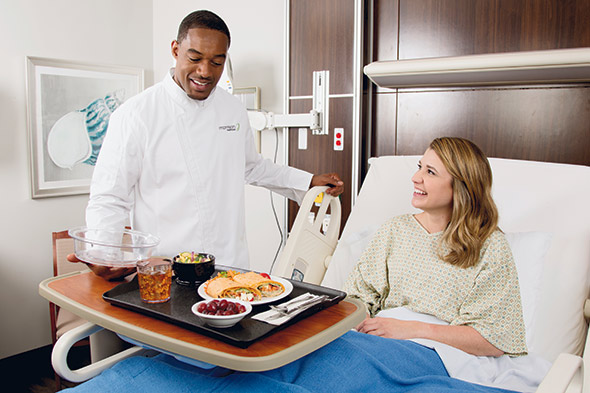
Happier patients are one result — patient satisfaction rates typically rise significantly when quality room service programs are instituted. But studies show that the benefits of offering on-demand room service with diverse and extensive menu options go significantly farther. Room service, it turns out, can also help to speed recovery because patients eat more and healthier foods. And by choosing what they actually want to eat and having it delivered when they actually want to eat it, less food is wasted.
“The option to have the flexibility to order food on your own schedule, with a variety of choices, is appealing to patients, especially to certain groups,” notes Laura Knight, vice president of Patient Services for Morrison Healthcare, based in Atlanta. “For example, maternity patients are experiencing new schedules and patterns in their day. Eating at a specific time doesn’t always work for them. Oncology patients, who can experience side effects of medication that can make them feel like eating at various times of the day, appreciate the option to order when they’re feeling well.”
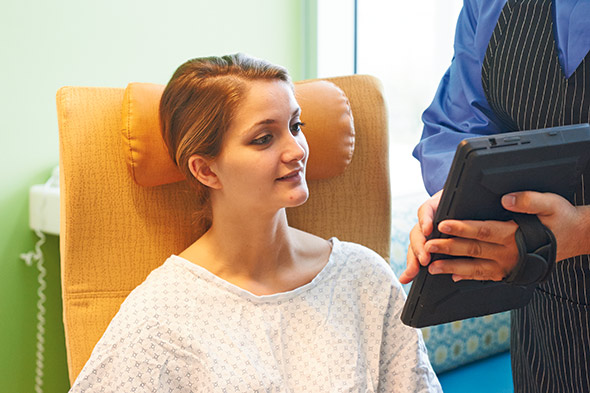 Morrison-managed facilities can tap two room service programs: Dining on Call, for patients able to place their own orders, and Catering to You, a restaurant-style program wherein a patient dining associate facilitates order-taking and meal delivery. Photo courtesy of Morrison Healthcare
Morrison-managed facilities can tap two room service programs: Dining on Call, for patients able to place their own orders, and Catering to You, a restaurant-style program wherein a patient dining associate facilitates order-taking and meal delivery. Photo courtesy of Morrison Healthcare
A national food and nutrition services company that is part of Compass One Healthcare, Morrison Healthcare serves more than 750 hospitals and healthcare systems. What’s important to keep in mind, says Knight, is that one size doesn’t fit all.
“While there are patients who resonate well with the flexibility of room service, it’s not a one-size-fits-all program,” Knight notes. “Our healthcare environment is shifting to include more older adults with a higher acuity of illness. Patients may not be able to order or plan in advance to make the call to order their meals. The personal connection of a patient dining associate who can assist with their selections at the bedside and bring their meals at a set delivery time can not only ease their minds but aids in the scheduled treatments that nursing is often tasked to juggle.”
That aging population gets credit for driving some of the most significant changes taking place in healthcare foodservice, notes David Reeves, director of Culinary Operations at St. Jude Children’s Research Hospital in Memphis, Tenn., and past president of the Association for Healthcare Foodservice. Baby Boomers, in particular, are making their mark.
“In the industry at large, Boomers are fast becoming the primary users of healthcare. They’re well-traveled and food-savvy,” Reeves says. “They come in with much higher expectations for being able to get foods that they want, when they want them. And both within the Boomer population and the broader healthcare industry, there’s now a much greater appreciation for the role that food and nutrition play in speeding recovery and enhancing wellness. Room service programs with a strong focus on freshness, quality and service can answer those needs.”
Here, three healthcare facilities provide a closer examination of the state of room service. In each case, the programs have shifted decisively away from traditional batch-production/trayline models to hospitality-inspired platforms characterized by diverse, chef-developed menus; kitchen operations designed and equipped for restaurant-style cooking to order; and high-touch service.
UCLA Health’s Staggered Approach to Production
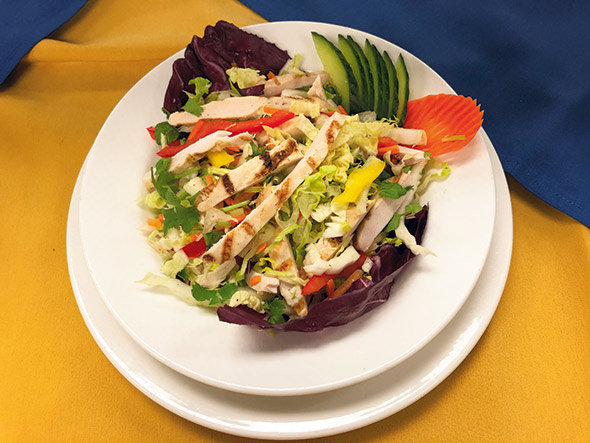 UCLA Health’s new room service menu features plant-based, protein-optional dishes such as Asian salads and Mexican bowls. Thanks to opportunities to customize, the menu offers 102 entree choices. Photo courtesy of UCLA Health SystemWhen most patients check in to one of the two primary hospitals within the Los Angeles-based UCLA Health system, they receive a menu that complies with the diet ordered by their physician. From then on, the hospitals’ Signature Dining program is just a phone call away, offering gourmet, hotel-style room service daily from 6:45 a.m. until 7:30 p.m.
UCLA Health’s new room service menu features plant-based, protein-optional dishes such as Asian salads and Mexican bowls. Thanks to opportunities to customize, the menu offers 102 entree choices. Photo courtesy of UCLA Health SystemWhen most patients check in to one of the two primary hospitals within the Los Angeles-based UCLA Health system, they receive a menu that complies with the diet ordered by their physician. From then on, the hospitals’ Signature Dining program is just a phone call away, offering gourmet, hotel-style room service daily from 6:45 a.m. until 7:30 p.m.
 Director of Nutrition Services Patti Oliver says her team’s focus, both for room service and foodservice in general, is on quality, nutrition, sustainability and innovation. A 2017 IFMA Silver Plate Award winner, Oliver oversees a program that serves 525 patient rooms at Ronald Reagan UCLA Health Medical Center, which was built in 2008 to replace the original earthquake-damaged UCLA Health Medical Center. Prior to the rebuild, the facility offered traditional tray service, and it continues to do so for a 75-bed neuropsychiatric hospital within the Ronald Reagan building. Her program also serves 300-bed UCLA Health, Santa Monica, where room service was introduced approximately 12 years ago, prior to a more recent full kitchen remodel.
Director of Nutrition Services Patti Oliver says her team’s focus, both for room service and foodservice in general, is on quality, nutrition, sustainability and innovation. A 2017 IFMA Silver Plate Award winner, Oliver oversees a program that serves 525 patient rooms at Ronald Reagan UCLA Health Medical Center, which was built in 2008 to replace the original earthquake-damaged UCLA Health Medical Center. Prior to the rebuild, the facility offered traditional tray service, and it continues to do so for a 75-bed neuropsychiatric hospital within the Ronald Reagan building. Her program also serves 300-bed UCLA Health, Santa Monica, where room service was introduced approximately 12 years ago, prior to a more recent full kitchen remodel.
Of the more than 9,000 meals served on average per day in the 2 centers, patient meals account for roughly one third, while the balance is retail and catering.
“When we first started doing room service, not many hospitals were doing it. We were fortunate to have a brand-new building at Ronald Reagan and to have our systems designed for room service,” Oliver says. “But it was still very challenging. We not only had a brand-new hospital that staff had to learn and get familiar with, but at the same time, we introduced a brand-new type of meal service.”
To accommodate on-demand room service as well as the needs of neuropsychiatry patients, who require regularly scheduled meal service, UCLA’s kitchens incorporate both a traditional hospital tray line, where staff portion and stage batch-cooked foods for set delivery times, and a restaurant-style line for freshly cooked meals to order. While the majority of its room service production is now cook-serve, cook-chill systems for items such as scratch-made soups and sauces are critical as well. In fact, UCLA recently added another blast chiller to help with volume needs.
The biggest ongoing challenge, Oliver notes, is meeting the needs and requests of all patients — and doing so within what is still typically a 90-minute window at each meal period for those not ordering room service. “Those who can’t have room service need to eat on schedule and you can’t limit when room service orders are accepted for the rest of the patient population. We’ve found that taking a staggered approach to production works best for us,” she says. “There are different units in the neuropsychiatric unit, so we send out 25 trays to 1 unit, then take some room service tickets, then send up 25 more trays, then do more room service, and so on.”
Dedicated Food Lifts
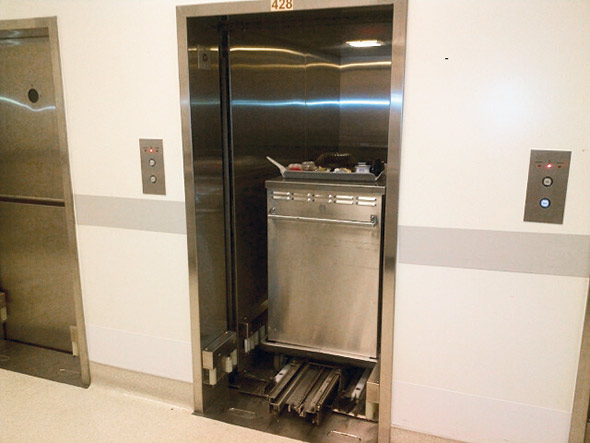 Room service patients are promised their meals within 45 minutes of ordering, but Oliver says actual delivery time averages 28 minutes. At Ronald Reagan, that’s due in part to the installation of four dedicated food lifts to transport room service carts from the basement kitchen to the building’s seven patient floors. Bypassing shared-use elevators significantly reduces delivery times and increases food quality by better maintaining food temperatures from cooking through delivery.
Room service patients are promised their meals within 45 minutes of ordering, but Oliver says actual delivery time averages 28 minutes. At Ronald Reagan, that’s due in part to the installation of four dedicated food lifts to transport room service carts from the basement kitchen to the building’s seven patient floors. Bypassing shared-use elevators significantly reduces delivery times and increases food quality by better maintaining food temperatures from cooking through delivery.
“We have a cart for each floor. Once the first tray is loaded, a timer is activated for seven minutes,” Oliver says. “When that timer goes off, it doesn’t matter if there’s one tray on the cart or several; it’s wheeled into the lift, sent up to the appropriate floor and whoever is receiving carts on that floor is notified that it’s on the way. The lift opens to a pantry, where things like hot beverages and ice cream are added to the trays just prior to delivery. That last step is important. It ensures that coffee’s hot and the ice cream is still frozen.”
Such attention to quality helps keep UCLA Health’s patient satisfaction with room service high, as does menu innovation. Long known for its commitment to healthful ingredients, from-scratch cooking and sustainable operations, UCLA also offers an uncommon level of choice. This summer, it introduced a Signature Dining menu that increased the number of available menu options to 102 from 59, thanks in part to opportunities for customization.
Developed in-house by UCLA Health’s executive chef and dieticians, the new menu focuses on plant-based entrees with proteins added upon request. “We’d been seeing a jump in requests for meatless menu options, so we increased vegetarian and vegan items on this menu by 49 percent,” Oliver says. “All of our salads now start out plant-based and you can add antibiotic-free chicken, shrimp or organic tofu.” The same holds true for the Mexican rice bowl, which starts as a vegetarian dish with optional add-ons such as marinated chicken and beef barbacoa, and the Indian curry bowl, which starts as a plant-based dish with optional add-ons such as chicken, salmon or tofu.
Looking ahead, Oliver says newer order-placement technologies such as TV- and tablet-based systems may factor into UCLA Health’s room service plans. But with a high percentage of patients for whom using handheld devices is challenging, being able to simply dial down for room service is, for now, just what the doctor ordered.
Johns Hopkins Health System’s On-Demand Hotel-Style Room Service
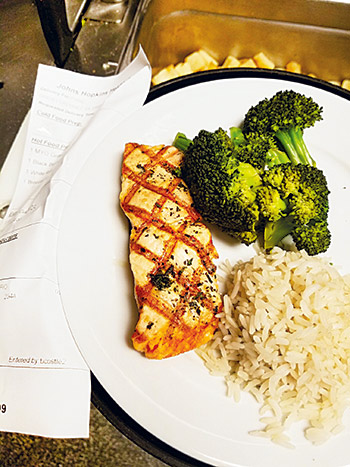 The At Your Request program at Johns Hopkins offers patients freedom to choose from among roughly 25 entree selections that staff prepare to order in central kitchens at each of six hospitals. Menus include traditional comfort foods along with chef-inspired, upscale, restaurant-style dishes. Photo courtesy of Johns Hopkins Health SystemAngelo Mojica, a 2013 IMFA Silver Plate Award winner who joined Johns Hopkins in 2016 as senior director of Food and Culinary Services, is a long-time proponent of hotel-style room service in healthcare. Introduced more than 5 years ago, the Johns Hopkins At Your Request program is available on-demand in all 6 hospitals, which together serve roughly 6,000 patient meals per day. Previously, Mojica oversaw the Restaurant Delivery room service program at UNC Health, where he served as director of Nutrition and Food from 2005 to 2015.
The At Your Request program at Johns Hopkins offers patients freedom to choose from among roughly 25 entree selections that staff prepare to order in central kitchens at each of six hospitals. Menus include traditional comfort foods along with chef-inspired, upscale, restaurant-style dishes. Photo courtesy of Johns Hopkins Health SystemAngelo Mojica, a 2013 IMFA Silver Plate Award winner who joined Johns Hopkins in 2016 as senior director of Food and Culinary Services, is a long-time proponent of hotel-style room service in healthcare. Introduced more than 5 years ago, the Johns Hopkins At Your Request program is available on-demand in all 6 hospitals, which together serve roughly 6,000 patient meals per day. Previously, Mojica oversaw the Restaurant Delivery room service program at UNC Health, where he served as director of Nutrition and Food from 2005 to 2015.
“There are a lot of reasons why on-demand, restaurant-style room service is much better than traditional tray service, for which patients typically place orders today for what they’ll be served at set mealtimes tomorrow. When we did that type of preordered meal service, we ended up wasting money in the long run,” Mojica says. “When meals were delivered, the patient might be out at a procedure, sleeping, not feeling well or no longer in the mood for what they ordered. A lot of things can change in a hospital overnight: Patients can move to different rooms, their conditions might change and they’re put on different diets, some go home early, some die. All of that has to be reconciled for orders placed the day before. And when trays are simply delivered on a set schedule, food quality suffers. Nurses frequently end up having to call down because a meal got cold or the patient couldn’t eat what was sent up.”
In contrast, the At Your Request program offers patients freedom and flexibility to choose from a menu that offers around 25 entree selections prepared to order in central kitchens at each facility. The service is available from 6:30 a.m. to 6:30 p.m. and patients receive their meals within 60 minutes of ordering. Alternatively, patients coming in for procedures or family members assisting patients can preorder meals and request delivery times up to two days in advance. Nutrition department staff members assist in selecting items appropriate for patients’ prescribed diet.
Menu Makeup
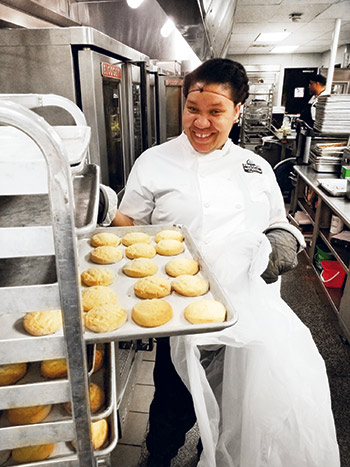 Menus at Johns Hopkins hospitals include traditional comfort foods along with chef-inspired, upscale, restaurant-style dishes that Mojica says help sell the sizzle. “A lot of people say offering too much choice is a bad thing, but I disagree,” he says. “We used to stick to offering a couple of simple comfort-food options, like meatloaf, macaroni and cheese, ham steak, etc., providing modifications here and there for restricted diets. You’re not going to get much credit from patients for that. Even if it’s good, it’s stereotypical hospital food.”
Menus at Johns Hopkins hospitals include traditional comfort foods along with chef-inspired, upscale, restaurant-style dishes that Mojica says help sell the sizzle. “A lot of people say offering too much choice is a bad thing, but I disagree,” he says. “We used to stick to offering a couple of simple comfort-food options, like meatloaf, macaroni and cheese, ham steak, etc., providing modifications here and there for restricted diets. You’re not going to get much credit from patients for that. Even if it’s good, it’s stereotypical hospital food.”
Mojica maintains that offering a menu that includes comfort foods along with some unexpected, upscale and nontraditional items gives patients freedom to choose and makes them feel good, even if they end up choosing the standards.
“The menu we ran at UNC had 93 entrees on it,” Mojica explains. “We had spicy Thai; we had salmon, sushi and shrimp; we had smoked brisket with slaw, baked beans and fresh cornbread. What did most people get? Chicken noodle soup, meatloaf, a milkshake, a slice of pizza — which cost us almost nothing. Our average tray cost came in well under the industry standard of $2. If everyone had ordered the sushi, which cost about $7 per tray, I’d have been out of business in the first week. In reality, we got about 5 orders a day for sushi out of a total of about 900, but it generated buzz and boosted patient satisfaction just for having it available. And for the few patients and/or family members who do order such options, you’re now their best friend. They don’t have to eat meatloaf or macaroni and cheese just because they’re in the hospital.”
Beyond offering diverse menus, Mojica suggests syncing hospital room service and retail menus makes sense and that’s something he hopes to introduce at Johns Hopkins. One benefit, he says, is the opportunity to cross-sell to visiting friends and family. Another is the opportunity to create advocates for the dining program among hospital staff, who can share opinions and help patients make selections based on their own experiences.
Ultimately, however, just as in commercial restaurants and hotel programs, true success with room service comes down to food quality. New ordering and tray tracking technologies, enhanced equipment to help ensure consistency and temperature maintenance tools are all great innovations, and they’re in play at Johns Hopkins, Mojica notes, but at the end of the day, it’s all about making great food that people want to eat, executing correctly and holding people accountable. “When you make the very best chicken noodle soup, when you let patients order it when they want, and deliver it nice and hot with a smile on your face, you make them happy,” he says. “And when you do that, your retail sales go up as well because staff and visitors want it too.”
St. Jude Children’s Research Hospital’s Unique Customization
With a single location in Memphis and 78 patient beds, St. Jude’s relatively small size and patient population make it unique. Devoted solely to children and adolescents suffering from cancer and other life-threatening diseases, the hospital is an anomaly in that some of the strongest forces impacting mainstream hospital foodservice programs — the aging population top among them — don’t apply.
Here, foodservice focuses squarely on creating menus and providing services that target St. Jude’s young patients and their families, many of whom have traveled from foreign countries to seek treatment at the world-renowned medical center. While from a room service perspective St. Jude’s feeding census might seem small, in reality, the population served through its program is significantly larger.
“We have a lot of outpatients going through treatment and testing who stay nearby in St. Jude-sponsored housing for weeks or months at a time,” Reeves says. “They’re on doctor-prescribed diets and they order room service meals that are delivered to them at our retail cafeteria, Kay Kafe. They use a special meal card as no patients are charged while they’re here. On an average day, we’ll do approximately 2,400 retail transactions just between 11 a.m. and 1:30 p.m. at Kay Kafe, which includes a lot of those outpatient orders. It’s a scenario that provides a unique level of operational complexity here. Most other facilities aren’t feeding outpatients on special diet orders through their retail venues.”
Within the hospital proper, all patients have access to on-demand room service and can choose from a core menu of 30 to 40 cooked-to-order entrees. Patients place orders via phone and staff prepare meals on a dedicated room service cook line in the operation’s central kitchen, where Reeves says newer accelerated cooking technologies — combi ovens, in particular — are mission critical both for quality and speed.
When ready, staff deliver orders via push carts. Food typically arrives 30 to 45 minutes after the kitchen team receives the order. Reeves estimates transit times from kitchen to patient room of 5 to 12 minutes. “We’re looking at technology to be able to better track trays and we’re implementing some software to help with that,” he notes, adding that leveraging technology will be increasingly important to St. Jude’s program, particularly as the hospital gears up for a major expansion in the coming years.
“Over the next few months, we’re also going to be implementing a new system through which patients will be able to order their meals via our TV-based education and entertainment system,” Reeves says. “And we’re working on ways to better leverage data available through our patient meal management service.”
Special Service
Given St. Jude’s size and the nature of its patient population, Reeves and his team are happy to be able to provide plenty of outside-the-box services. These can range from hugs from the chef delivered along with meal trays to fully customized meals that help ensure kids eat and get the nutrition they need help them withstand treatments and heal.
“We’re not only treating a domestic population for whom things like chicken nuggets are enduring favorites,” Reeves notes. “We have a lot of international patients who have very different favorite dishes and comfort foods. That’s where our chefs really get involved — meeting with parents or other family members to learn what types of foods their child would be comfortable with, learning techniques and sourcing ingredients to go beyond the core menu and prepare those dishes. We’ve even had some cases where a parent has come down to the kitchen to teach the chef how to prepare a child’s particular favorite dish.”
Reeves describes a recent scenario in which the patient herself made a foray to the kitchen. “We had a very sick young girl from Mexico who hadn’t eaten in nearly two weeks,” he says. “The only thing she wanted was her family’s enchiladas, so we got clearance and made the proper arrangements to have her brought to the kitchen so that she could show the chef how she likes her enchiladas prepared. When they were done, she gave him a big hug, thanked him through a translator, and went back to her room and ate. Those types of things happen here and it shows the importance we put on the element of food. It’s for nutrition, yes, but it’s also about comfort and caring for the patient. Our department’s mission is to make a difference in the lives of those we serve every day. We happen to do that through customer service and food.”



